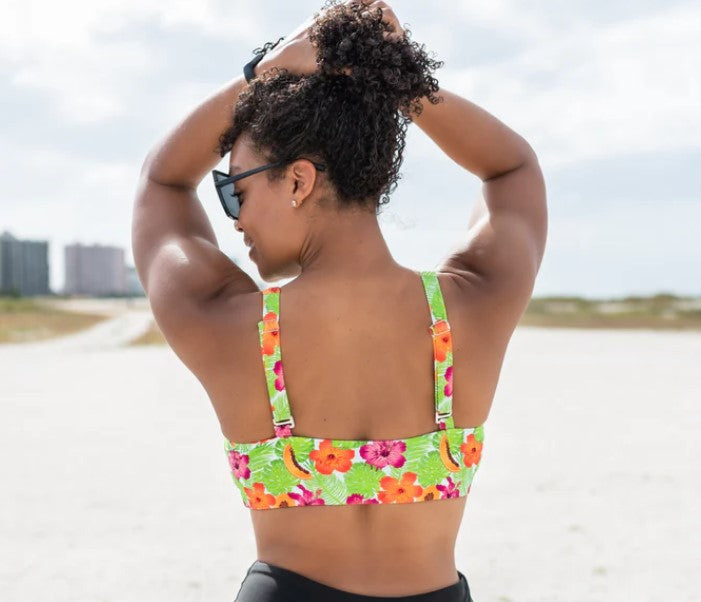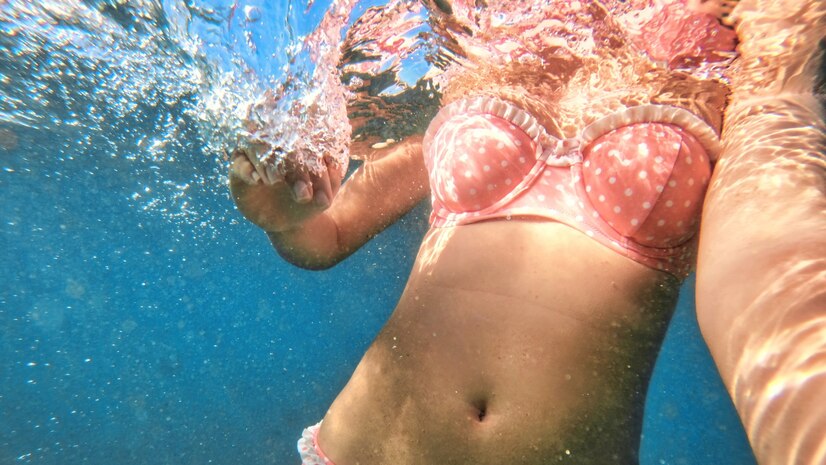
How long does a tan last?
A tan can last anywhere from 7–30 days, though a natural tan will usually fade after a couple of weeks. Your fade time will depend on how long you were exposed to UV radiation, the UV index, your skin type, and other factors we’ll explore below.
Quick links:
What is the Fitzpatrick skin type scale?
How does skin type influence tan duration?
How long does a tan last on dark skin?
How long does a tan last on light skin?
How long does a natural tan last?
How long does a sunbed tan take to fade?
How long does a spray tan last?
Here are the main factors that influence how long a tan lasts:
- Tanning method (sunlight, tanning bed, etc.)
- Skin type
- Intensity of UV radiation
- Length of time exposed to UV radiation
- Skin care regimen after tanning
We’ll go into more detail on each of these. Let’s start with a discussion of skin type.
What is the Fitzpatrick skin type scale?
The Fitzpatrick scale categorizes skin types based on melanin concentration. Melanin is a natural pigment responsible for the coloration of skin, hair, and eyes.
Lighter Fitzpatrick skin types lose their tan faster, burn more quickly, and have a higher risk of skin cancer and skin damage from UV exposure. Darker Fitzpatrick skin types keep their tan longer, burn more slowly, and have more protection from UV radiation.
Use the chart below to figure out your Fitzpatrick skin type—and plan your tan accordingly.

How does skin type influence tan duration?
A scientific model by Thingnes et al. suggests that higher melanin production results in a longer-lasting tan. Particularly, people with eumelanin (a subtype responsible for black and brown pigmentation) develop deeper and more durable tans.
UV exposure stimulates melanocytes (melanin-producing cells) to produce even more melanin. If you have more melanocytes–meaning that you’re already darker–you’ll darken at a faster rate than someone with fewer melanocytes. And you’ll stay darker for longer.
How long does a tan last on dark skin?
Dark skin keeps a tan for longer because there are more keratinocytes (outer pigmented cells) for the skin to shed. Keratinocytes are fully recycled from the outer epidermis every 4–6 weeks, so a tan will be fully gone at that time. You’ll have a gradual fade, from full tan to your natural skin color, so after a couple of weeks, your tan will be less strong.
If you have black or brown skin, your skin will still burn after excessive or intense UV exposure. Everyone’s skin is at risk of short and long-term damage from the sun. When outside, apply sunscreen of at least SPF 30 and wear sun-protective clothing to keep your skin healthy.
How long does a tan last on light skin?
If you have a Fitzpatrick skin type I–III, your tan will be mostly gone after a couple of weeks, because you have fewer keratinocytes to turn over.
People with light skin have a harder time tanning, fade faster, and are at a higher risk of burning and developing skin cancer. You should take extra care when exposed to UV radiation if you fall into this category.
You can protect yourself from the sun’s harmful rays by wearing sunscreen of SPF 30+ and covering bare skin. Long-sleeved shirts, long pants, and a wide-brimmed hat are effective ways of safeguarding your skin. Skin burns more quickly underwater, so wear sun-protective swimwear when swimming.
How long does a natural tan last?
A tan from being outside will last an average of 7–10 days. The sun’s UV rays stimulate melanin production in the cells of the outer skin layer, so once these cells are shed, you are left with your original skin tone. More melanin is produced after UV exposure as the skin’s natural defense. Melanin absorbs UV and protects the skin, but also darkens the skin into what we perceive as a tan.
Keeping your skin hydrated is one way to slow the shedding cycle. Though it sounds counterintuitive, gentle exfoliation can prolong your tan too. Dead skin cells look dull and pale, blocking a tan’s glow.
A more intense tan will fade slower, but it’s not worth risking long-term skin damage for a longer-lasting tan. Your skin still tans if you’re wearing sunscreen, so still take preventive measures against the sun’s harmful rays when sunbathing.
How long does a sunbed tan take to fade?
On average, the tan from a sunbed lasts 7–10 days, the same amount of time as a natural tan. However, there are high-intensity tanning beds that can give you a tan for up to 30 days.
Tanning beds mimic the sun’s rays by emitting UV radiation. There are two main types of UV radiation: UVA and UVB. Many of the negative effects of UV exposure are a result of UVB radiation. These rays are high energy and low wavelength, resulting in fast damage to the outer epidermis. UVA rays have a lower energy and higher wavelength, so you can get a deeper, more intense tan.
Most tanning salons offer low-pressure sunbeds that emit both UVA and UVB rays. High-pressure tanning beds use specialized bulbs that give off a higher concentration of UVA rays and block most of the UVB. This allows for a more robust and longer-lasting tan.

*27-30 days represents the upper limits of tan duration from a high-intensity sunbed. Individual people may experience different results.
Even though it is a controlled environment, you can still get a burn from UV exposure in a tanning bed. Always wear eye protection during tanning sessions and limit your time inside for the best results.
How long does a spray tan last?
Sunless tanning products give your skin a golden glow without any risk of damage. Spray tans and self-tanners contain a chemical compound called dihydroxyacetone that temporarily darkens the outer layer of skin. These tanning methods lead to a shorter tan of only 5–7 days, though this time will vary from product to product. How well you maintain your tan afterward will also alter tan longevity.
Read the instructions on self-tanners before applying for maximum results and avoid an uneven tan. Sunless tans sometimes need hours to develop, so leave some time before showering.
Tan duration FAQ
Why does a tan fade?
A tan will fade as the skin sheds its outermost layer of cells. The outer layer of the skin is constantly regenerating as dead cells are replaced by new ones. There is a natural turnover as tanned skin cells shed and lighter-colored cells from the deeper layers come to the surface.
How do I make my tan last longer?
The best way to maintain a tan is to keep your skin moisturized. Using products like oil-based moisturizers or after-sun lotion can make sure your skin cells stay hydrated. Specialized after-sun creams both moisturize the skin and help alleviate any burns you may have. Drinking plenty of water also keeps your skin hydrated and will allow it to stay tan longer.
Excessive water exposure can make a tan fade faster, so avoid long baths or showers. Hot water strips the skin of its natural oils and moisture, so shower with lukewarm or cold water to keep your tan. Gentle exfoliation can also help a tan last. The dead cells on the outermost layer of your skin can appear dull and pale, so a light scrub will help maintain a healthy glow.
How can I get a good tan?
The best way to get a tan is through gradual exposure to ultraviolet light. Overexposure can have serious life-long effects, so avoid the midday peak hours and stick to short periods of time outside. You can check the UV index for the day to see your risk of burning.
When outside, use sunscreen of at least SPF 30 to protect your skin from damaging sun exposure. Sunscreen cannot block 100% of the sun’s rays, so your skin will still tan while you stay safe. Reapply every couple of hours for the best protection, especially after going in the water.
Do tanning lotions lead to a longer-lasting tan?
Tanning lotions can lead to a longer-lasting tan and faster tanning, though these products should be used with caution. They help you tan faster by boosting melanin production but do not protect you from UV damage. Protect yourself by applying broad-spectrum sunscreen and wearing a long-sleeved shirt, long pants, and a wide-brimmed hat. Sunscreen does not block 100% of the sun’s UV rays, so you can still get a tan while being safe. To increase the production of melanin in a sunbed, use indoor tanning lotion.
How do you make a tan fade faster?
There are skin-lightening products you can use to make a tan go away quicker. Look for creams with glycolic acid, a chemical that breaks down the color of a tan. Lemon juice can be used as a natural removal treatment as well. Squeeze some lemon juice on your skin and rinse it off after a few minutes to take advantage of its bleaching properties. Regular exfoliation and hot showers can also help a tan fade faster.
Does sunburn turn into a tan?
Sunburn doesn’t turn into a tan, but after it heals you may see the tan that was underneath. Sunburnt skin must heal or peel away, revealing the layer beneath it afterward. Getting a sunburn is not an effective or healthy way of tanning. Chronic sunburn can lead to premature aging and skin cancer, so avoid any excessive UV exposure.
Further reading
How long can I tan in the sun?



Leave a comment
This site is protected by hCaptcha and the hCaptcha Privacy Policy and Terms of Service apply.